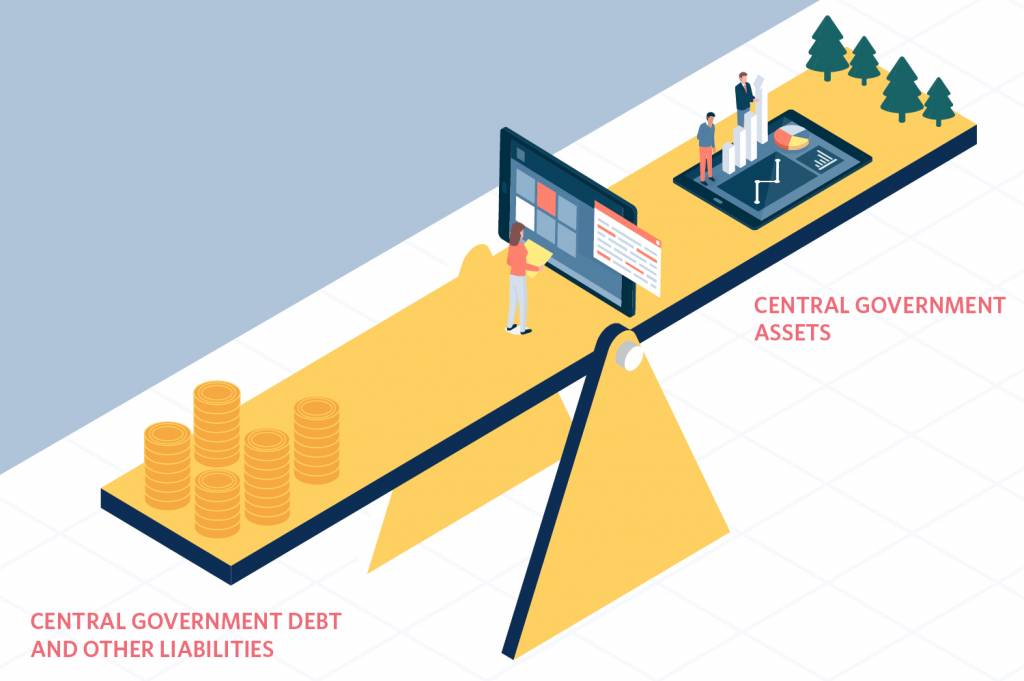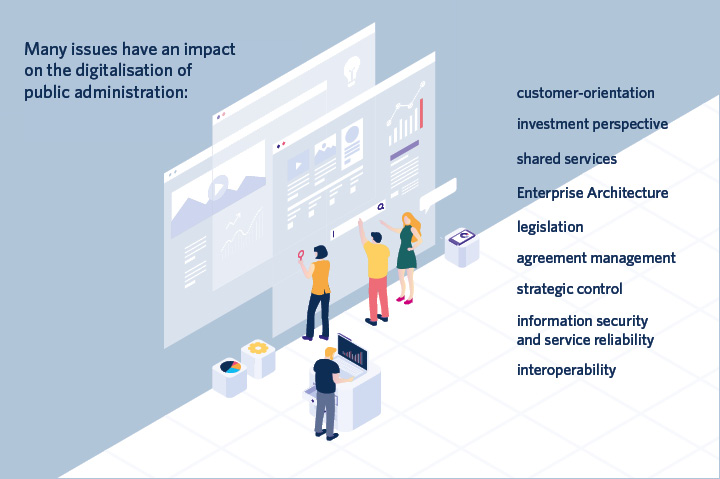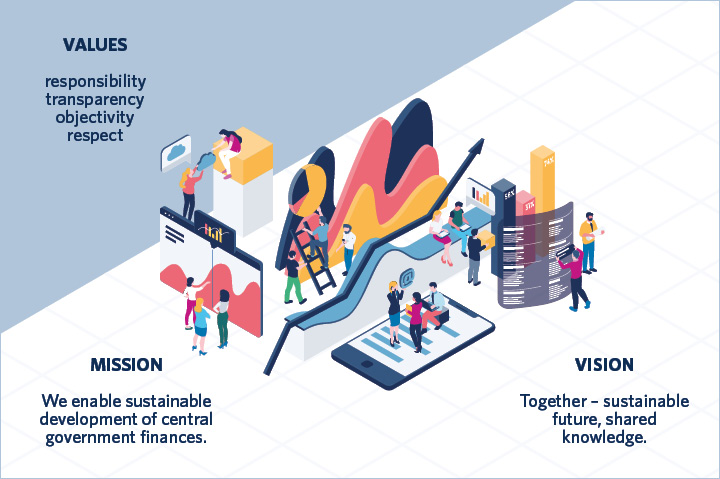In its Annual Report, the National Audit Office of Finland presents summaries of the audit findings that are of material importance to Parliament as well as the conclusions made on the basis of audit findings concerning the current state of central government finances and public administration. In addition, the NAOF presents a review of its activities during the annual report period.

Auditor General’s review: Building a better future
The 2010s have been characterised by the emergence of the New Normal concept in the political debate. Climate change, structural demographic change, and the post-crisis economy – which is difficult to forecast – increase pressures to revamp political activities radically. Short and long-term goals are competing for attention in politics. People are attracted by promises, the fast food of politics – initially tempting, but ultimately empty and unsatisfying. The New Normal gives central government a strong reason to undergo changes and develop its operations.
The New Normal implies we should accept that there is no going back once a big change has taken place. In the economy, the financial crisis of 2008 is considered to mark one such watershed. In policy-making, the cross-sectoral approach, speed of operations, and requirements for stakeholder engagement are part of this change.
Today, political decision-makers and public officials have a greater amount of high-quality information at their disposal than before for planning and monitoring political actions. On the other hand, the New Normal also entails a huge volume of information and lots of interconnections. It can even be difficult to utilise information under the pressures imposed by fast-reacting media, social media, and ever-increasing publicity. In addition to a common, clear and consistent story, it is also important to consider alternative futures. The planning of central government finances and operations always aims at supporting the current political vision about the future of Finland.
A good example of people’s commitment to building a better future is the United Nations’ Agenda 2030 for Sustainable Development. Through the commitment, which spans the years 2016–2030, the member states want to help the planet cope with the challenges of ecological, social and economic disparities. Dag Hammarskjöld, the second Secretary-General of the UN, reflected in 1955 that “everything will be all right… when people… see the United Nations as a drawing they made themselves”. He meant that people become estranged from the common goals when the picture they have of public administration looks abstract and complicated. He also strongly believed in people’s ability to build a better future together. The Sustainable Development Goals (SDGs) help to make people feel responsible for societal development – to take ownership of their future.
The changing operating environment encourages public administration to operate more transparently
Prime Minister Antti Rinne’s Government Programme identifies the need to adjust political operating models to the New Normal. Longer-term planning and parliamentary commitment to common development goals increase the likelihood that demanding structural changes will actually be implemented. If political goals and actions are prepared on a broad front, and different scenarios are considered, it is easier to manage even demanding cross-sectoral entities. When public administration performs central government tasks in a more transparent and inclusive manner, citizens will become more engaged and socially included.
The reform of public services aims at making them flexible from the customer’s perspective. However, when transparency and engagement increase, it is necessary to ensure that there is sufficient risk management competence in public administration. The National Audit Office of Finland (NAOF) recommends that central government should have a more comprehensive risk management policy. This would prevent unexpected events from paralysing central government’s capacity for service provision. Risk management is also needed to create an overall picture of central government and its finances. It would also improve people’s confidence in central government operations.
Managing finances means managing the future
The reform of central government provides a good opportunity to review the practices used in the management of central government finances. Phenomenon-based budgeting and more comprehensive risk management in central government can promote the impact of cross-sectoral political efforts. The spending limits procedure applied to central government finances supports the sustainability of public finances. The spending limits procedure should be developed to improve its transparency and to make practices meet the needs of the new kind of policy-making. In the spending limits system, it is crucial that the items falling outside the scope of spending limits expenditure are well-grounded, and that the spending limits are defined and applied consistently. During the last parliamentary term, this line of demarcation was vague particularly in the case of financial investments and donated shares.
Off-budget funds were set up to be separate from the rest of central government, and separate laws were enacted on the duties and operations of each fund. However, in practice, these funds are not always separate from the budget, and they are used increasingly for paying government aid instead of credit granting and investment activities. It would be appropriate to keep government aid activities on budget, which would expand the coverage of the spending limits procedure and strengthen Parliament’s budgetary powers.
The NAOF has consistently highlighted the need to develop central government’s financial planning and management. The management of central government finances could be improved by central government’s consolidated balance sheet, which would include not only on-budget entities and funds but also state-owned companies. This would also ensure that the central government assets are taken into account more comprehensively in the annual financial planning process.
Consolidated reporting would make it easier for the decision-makers to gain a wider picture of general government finances. The business form and objectives of state-owned companies and unincorporated state enterprises should be assessed on a regular basis from the perspective of central government finances and societal impacts, taking into account changes in their business and customer groups. There is an opportunity to influence this issue when the next Government resolution is prepared. The recommendation issued by the Ministry of Finance in 2018 about the reorganisation of state operations and, in particular, the principles of incorporation lays a good foundation for the preparation.

Sustainable development can be supported by linking long-term goals with the budget
Finland is committed to the United Nations’ Sustainable Development Agenda and Goals. Through Agenda 2030, the operations of the State of Finland are linked with the global development and respond to the changes resulting from the climate change and the demographic change.
The International Organisation of Supreme Audit Institutions (INTOSAI) reported on the national implementation of Agenda 2030 at the July 2019 UN High-level Political Forum on Sustainable Development (HLPF). The INTOSAI pointed out that, based on the SDG audit results:
There are challenges with aligning national budgets with the SDGs; have we got the money necessary for the implementation, and has the implementation of the SDGs been planned seriously?
Coordination within government and stakeholders still needs to be enhanced to overcome the traditional government silos and top-down approach.
Lack of information quality and availability has led to gaps in our knowledge and challenges to evidence-based decision-making.
Optimally, the Sustainable Development Goals are clearly linked with the public interest in national implementation. Success in this requires that the whole society is engaged on a large scale, that open feedback procedures are introduced, that strategies are better integrated into the budget procedure, and that the results are reported on transparently.
In Finland, we should strengthen the political consensus on the need to extend sustainable development policies over different government terms. The capacity of public administration to respond to multidimensional political problems will improve if we commit to the goals of Agenda 2030 on a broad front and during the entire programme period 2016–2030. Nevertheless, the impact of the SDGs on the planning of general government finances and the preparation of the budget is still scarce. Linking the goals with the budget would enable the central government to operate more comprehensively, uniformly and consistently.
Consistent politics promote the cost-efficiency of central government
The concept of the New Normal also refers to the volatility of politics and the culture of putting out fires. Nevertheless, in addition to short-term political decisions, the need to steer the central government operations consistently and efficiently has been recognised. Apart from structural changes, the sustainability gap also sets requirements for central government finances. It is therefore necessary to ensure in the planning and implementation of public sector operations that the different central government policy sections do not operate in a mutually exclusive or contradictory manner. A commonly used example of this is the conformity of the government subsidies provided to companies with the environmental goals.
The SDGs are cross-sectoral in nature, and their impacts cannot be limited to a single nation state. As regards the implementation of the SDGs, it is essential to link long-term goals with national decision-making and to ensure the consistency of different policies. It is also necessary to ensure the interoperability of the different administrative branches and to engage the whole society in the implementation of the goals. The need for consistency applies to all administrative branches and structures from the national to the local level. In Finland, central government operates in silos and local self-government makes independent decisions. Therefore we need comprehensive and inclusive preparations in networks. The Finnish Society’s Commitment to Sustainable Development (Commitment 2050) is an excellent example of the inclusion of the whole society.
Agenda 2030 is a truly global commitment, which makes it important to consider the spillover effects of actions taken by Finland on other countries, as well as the cooperation between countries. Finland has succeeded in being profiled in the UN as an expert in sustainable development. Finland shares its expertise actively and seeks opportunities for collaboration. This has far-reaching impacts on Finland’s opportunities to succeed in the international competition. International cooperation also ensures that we can utilise the good ideas and experiences of other countries in the development of the public administration in Finland.
Continuous learning generates belief in the future
As regards the management of central government finances and operations, there are many good tools available for building a better future. Politicians have recognised the need for preparations on a broad front and for planning that extends over several government terms. The building blocks for a better future are there to encourage the public officials to engage with stakeholders, to manage phenomena consistently, and to work in networks. The reform of the operating models of public administration also requires that public officials are provided with goal-oriented training and support for continuous learning in their daily duties.
As part of the wide-ranging reform of central government, the NAOF is also undergoing changes. We meet the need for continuous learning by developing our operating models and organisational structures, which are centred around people’s ability to increase their competence and cooperate. Our goal continues to be providing Parliament with relevant and timely audit information to support decision-making. I want to thank the NAOF’s personnel for their ambitious and enthusiastic attitude towards the changes. By creating operating models based on transparency and interaction, we can increase the added value that our audit work provides to society. The New Normal is inspiring and offers opportunities.

Central government assets should be managed as a whole
Assessments of the state’s financial position do not always take sufficient account of central government assets, although their value equates to central government debt. The value of central government assets amounts to approximately EUR 100 billion. In addition to financial yield, the major part of the state assets also has other purposes. The heterogeneity of the assets makes it important to manage each asset type appropriately and to avoid resorting to various exceptional solutions. Investments and divestments should be based on plans.
The state has accumulated assets of many different types over a long period. In addition to owning land and forests, buildings, and roads and railways, the state also has a considerable number of holdings in companies. A key characteristic that distinguishes central government assets from those of the business world is that central government assets very often also have other purposes than merely providing yield. It is therefore important to identify the kind of asset in each case and to follow the principles suitable for the management of that specific asset type. When decisions on assets are made, it is thus usually necessary to consider other targets in addition to the yield target and to reconcile these potentially contradictory aspects.
A yield-based approach is not right for all state assets – even if it were possible. Where the maintenance of transport infrastructure is concerned, for example, the socio-economic perspective outweighs the provision of direct yield. In this case, it is also important to manage the asset lifecycle costs. The balance sheet value defined for the state-owned transport infrastructure is about EUR 20 billion. Of this, roads account for about EUR 15 billion, railways EUR 4.8 billion, and waterways EUR 200 million. The transport infrastructure asset valuation is mainly based on the acquisition cost.
State-owned business always pursues profit
A third of state assets, about EUR 38 billion, consists of holdings in companies. Of this, about EUR 28 billion are holdings in listed companies directly owned by the state. There are about 50 unlisted companies. The state’s Ownership Steering Department has valued them at about EUR 10 billion.
In the management of its holdings, the state aims to achieve the best possible socio-economic total result. The state expects the companies to yield profit, that the value of its holdings develops favourably, and that the companies operate sustainably and cost-effectively. The state’s expectations of its different holdings are mainly determined by the state ownership policy and ownership steering. The state’s holdings are categorised based on the primary target set for each holding. Some holdings only have a financial interest, i.e. they are expected simply to provide a good return on investment and increase in value.
In its ownership policy, the state has defined some state holdings as strategically important. It is considered important, for example, that the state has holdings in the energy sector. The highest value holdings of strategic interest are those in Fortum and Neste. The companies of strategic interest operate on commercial grounds and are expected to yield profit and increase in value.
Certain companies are defined in the ownership policy as ‘special assignment companies’. They have been established to perform one of the state’s duties: e.g. Alko has been tasked with the retail sale of alcohol, Veikkaus with gambling games, Finnrail with railway traffic control, and Finnvera with financing services for export companies. The thirty special assignment companies form a highly heterogeneous group, and not all of them aim to yield profit. However, the companies’ operations must be efficient and self-supporting, i.e. they must manage with their own revenues.
The state’s important real estate assets have remained in unincorporated state enterprises, which the state has otherwise mostly relinquished. Approximately EUR 4 billion in land and water assets have been consolidated with Metsähallitus, while building properties of approximately EUR 4.5 billion have been consolidated with Senate Properties.
In addition to performing public administration duties, Metsähallitus also conducts business related to land and water areas. In cases where the same holding is involved in both commercial and administrative operations, it is important to keep these operations separate. Yield-producing assets should also be valued realistically to ensure that the yield requirement set for each unincorporated state enterprise is correct. In its audit, the National Audit Office of Finland states that the value of Metsähallitus has been defined prudently and that it should be re-valued sufficiently frequently.
It is the duty of Senate Properties to provide central government with premises cost-effectively to meet the state’s overall interest. As the provider of state premises, Senate Properties has a priority position as a unit connected with the purchasing unit. However, for competition reasons, this position restricts Senate Properties’ operations in other markets.
The NAOF has recommended a regular assessment of the business form and objectives of state-owned companies and unincorporated state enterprises from the perspective of financial results and societal impacts. Their business and customer groups may undergo changes that may make it necessary to consider changing their business form. The current business of the icebreaking services company Arctia Oy, for example, relies strongly on the orders of the Finnish Transport Infrastructure Agency, which means that Arctia now has weaker grounds for operating as a company. Accordingly, the principles of state asset management have been clarified. In addition to the ownership policy, which applies mainly to holdings in companies, the Ministry of Finance drafted guidelines on the criteria for selecting different forms of operations in 2018.

Central government assets are versatile.
Funds are off-budget assets
The 11 state funds hold slightly less than a third of the state assets, a total of about EUR 30 billion. The funds have been set up to be separate from the rest of the central government finances. Separate laws have been enacted on the duties and operations of each fund.
In practice, however, based on the audits carried out by the NAOF, the funds are not always separate from the budget. For instance, the operations of the Development Fund of Agriculture and Forestry (Makera) and the National Housing Fund have changed from granting loans to paying government aid. In Makera, this change has already led to a situation where the capital reserves of the fund are no longer sufficient for normal operations, but the fund needs regular budgetary transfers. The National Housing Fund has capital reserves of more than EUR 6 billion, ensuring it will be able to continue its operations for a long time. New uses, such as transport infrastructure projects, have also been planned for its assets. If the operations of the fund are expanded, it should be examined whether the new operations meet the requirements set for fund operations.
Although the main purpose of funds is often something other than providing financial yield, the fund that is by far the biggest – the approximately EUR 20 billion National Pensions Fund – has been established to ensure that its savings provide yield. Although it is a fund, it is managed in much the same way as pension companies, and its investment policy is restricted by the same rules. The operations of the fund are also restricted by the target size set for it: 25 per cent of the state’s pension liability. It would be justifiable to assess the appropriateness of the target size, as in view of the current value of the fund, the target size laid down may steer the fund to invest too prudently and thereby unnecessarily weaken its yield.
Although the investments of the National Pensions Fund are regulated in the same manner as those of a pension company, the fund is not tied directly to the payment of individual pensions. It serves as a kind of buffer savings fund for the state, holding a fifth of central government assets. Its assets have been used to balance the budget, and transfers larger than planned have also been made to it in good times. To ensure that the fund can operate cost-effectively, its target size and the restrictions to its investment policy should be re-assessed.
Asset management should also consider the big picture
Currently, central government’s assets are approximately equal to its debt. However, debt and assets are taken into account in clearly different ways in decision-making: central government debt is almost always considered as a whole, whereas central government assets are considered as individual holdings.
When asset items are considered separately, there is a risk that the difference between minor and major issues will be missed. Another risk is that issues related to the big picture, such as the targeted amount of the asset, will be forgotten. Without an overall review, it is also easier to end up with various exceptional solutions that would be contrary to the overall interest of asset management if used on a larger scale. For example, an individual fund can be subsidised from the state budget, but if applied on a larger scale, such a practice would erode the budget process.
Efforts have already been made to improve the overall management of central government assets. One of the planned measures has been the drafting of a consolidated balance sheet for the central government. This would ensure that the assets are taken into account in the annual budget process. However, despite attempts, the consolidated balance sheet remains unimplemented. Instead, assets are reported more comprehensively in the final central government accounts through the total balance sheet.
Assets are always a certain kind of means of preparedness. Divestment of central government assets should always be based on plans and linked to long-term strategic goals. When the financing of investments is considered, debt and borrowing should always be examined as alternatives to divestment of assets. After divestment, assets no longer yield profit.
From the perspective of the spending limits in the central government budget, it is not cost-effective to divest state assets without consideration and reallocate them in the event of corporate restructuring, for example. Another deviation from budget principles is tying funds received from assets to a specific use. Keeping income and expenditure systematically separate ensures that all use of funds is strictly considered.
Additional information
This chapter is based on the following audits and follow-ups from which there is a link to vtv.fi (the link will open in a new window):
Capital management in state funds (16/2018) (Opens in a new tab)
Organisation of state-owned business operations (14/2018) (Opens in a new tab)
Metsähallitus as a manager of state-owned land and water areas (1/2018) (Opens in a new tab)
The 2018 financial audit of Funding Agency Business Finland (Opens in a new tab) (in Finnish)
Total central government balance sheet (19/2015) (Opens in a new tab)
Private equity investment operations of the state (15/2016) (Opens in a new tab)

Compliance with the principles of good governance has improved in the management of central government finances
In the management of central government finances, good governance means that the operations are cost-effective and comply with both the law and the budget approved by Parliament, and that the agency’s internal control and risk management are organised effectively. The National Audit Office of Finland audits the effectiveness of good governance in connection with its financial audits. In 2018, the NAOF issued fewer cautions about defects than in previous years.
Defects in every fourth accounting office
The NAOF audits the financial statements of the state, ministries, agencies obliged to prepare financial statements, and three off-budget funds. In its financial audit report, the NAOF comments on four issues: whether the financial statements include true and fair information; whether the accounting office provides true and fair information on its operational efficiency; whether the accounting office has effective internal control; and whether the accounting office has complied with the budget. It is also possible to issue cautions on the budget procedures in the financial audit report. The NAOF can oblige the management of an audited agency to report to it on the actions taken to remedy the state of affairs for which the agency was cautioned. This is called the obligation to report.
The NAOF issued 67 financial audit reports for 2018. Most of the audited entities – the three funds and 47 accounting offices – received a clean financial audit report, i.e. the NAOF found no defects in their financial statements or financial management procedures. However, the NAOF did find defects in 16 accounting offices and in the final central government accounts, and issued cautions regarding these. Every fourth accounting office was thus cautioned, which is a significant number. Nevertheless, the number of cautions has decreased: in 2017 and 2016, every third accounting office was cautioned.
In the audit of its 2018 financial statements, the Finnish Transport Agency was cautioned for defects in three areas: the presentation of financial statement information; the organisation of internal control; and the legality of financial management. The Finnish Transport Agency was also cautioned for its budget procedures, and an obligation to report was also imposed. The Ministry of Finance was issued with the same cautions as the Finnish Transport Agency.
Tähän tulee visualisointi
The dynamic visualisation (Opens in a new tab) provides information on the cautions and disclosure requirements issued by the National Audit Office in its audits in 2016, 2017 and 2018. The same data is available in the Excel file below.
Compliance with the budget has improved
The NAOF audits whether the central government finances are managed in compliance with the state budget approved by Parliament. In its financial audit reports, the NAOF comments on compliance with the budget and the key statutes related to it. If the budget or the key statutes have not been complied with in all respects, the NAOF issues a qualified opinion on regularity.
Qualified opinions on regularity usually concern individual areas or procedures in financial management. For example, an opinion is often issued because an appropriation has been spent during the wrong budget year or for a purpose other than the one for which it was granted. Sometimes income may have been entered as available to be used by the agency’s own operations even though, according to the budget, it should have been included in the state’s cash reserves. Such procedures are contrary to the budget and often also to budget legislation. A qualified opinion on regularity should be considered a serious issue for the financial management of the agency in question. However, a qualified opinion on regularity does not mean that the agency’s or central government’s finances have been managed contrary to law as a whole, or that central government assets have been misappropriated.
The NAOF found procedures contrary to the budget and the related key statutes in the audits of seven accounting offices: the Office of the President of the Republic of Finland; the Ministry for Foreign Affairs; the Ministry of Finance; the Ministry of Transport and Communications; the Finnish Immigration Service; the Finnish Transport Agency (now the Finnish Transport Infrastructure Agency); and the Development Centre for ELY Centres and TE Offices. The number is slightly down from previous years.
A qualified opinion on regularity can also be issued on procedures that are contrary to other statutes applying to asset management. In the 2018 financial audit, the Finnish Transport Agency was cautioned for a groundless write-down on the assets transferred to the traffic management company and for purchase prices of land areas and contractual penalties deviating from fair value. These procedures were contrary to Section 14 of the State Budget Act, Section 66 g of the Budget Decree, and Section 5 of the Act on the Right to Transfer State Real Estate Assets.
Based on the number of individual cautions and cautioned accounting offices, budget compliance improved in 2018. There seem to be two reasons for the positive trend. First, flexibility related to budget content has increased. This means, for example, that budget grounds have been formulated more generally to enable a more flexible use of appropriations. Another factor behind the positive trend may be the improvement in the centralised controls and guidelines of the Kieku system.
Audit of internal control aims to improve operations and processes
The shared goal of financial audits and the audited entities is to develop processes to ensure operations comply with regulations. Financial audit and internal control strive to fix problematic processes and procedures immediately.
Internal control refers to those procedures and organisational solutions in the steering and operational processes by means of which the agency ensures the legality of its operations and finances, budget compliance, and the safeguarding of its assets.
Defects in internal control are not always directly linked with central government finances. The operational processes of central government cover billions of euros each year. It is therefore necessary to control the risk of errors and misappropriations related to them by sufficient internal control procedures.
The NAOF found individual defects requiring substantial action in the internal control of ten accounting offices in 2018. This corresponds to approximately every sixth accounting office. The number of cautioned accounting offices was down from previous years. A caution on internal control may relate either to the accounting office’s own actions or to those of the service centre responsible for the accounting office’s centralised financial management.
Significant defects in the introduction and procedures of the Handi procurement system
In 2018, the Handi system was launched at Palkeet, the Finnish Government Shared Services Centre for Finance and HR, as part of the programme for the digitalisation of procurement. Handi enables easy electronic ordering and advanced automation of invoice processing. Handi will replace the currently used order management system Tilha, and the invoice processing and filing system Rondo. Palkeet provides the Handi shared services to the central government accounting offices.
The audit conducted found significant defects in the organisation of Handi’s internal control and in the introduced procedures’ compliance with statutes. The defects have resulted in the payment of expenses deviating from spending decisions and in the erroneous processing of expenses in accounting.
To ensure efficient processing of procurement and expenditure in central government, the customers of the service centre must be able to rely on the operation of Handi. It is not acceptable to introduce the system while it is still incomplete and insufficiently tested, and to postpone the testing from the introduction project to service production. This involves the risk of errors in the payment, posting or filing of expenses, of the process functions not including all the processing steps required by legislation, or of the filed receipts not including all the information required by legislation. The organisation of Handi’s internal control has also been complicated by the fact that risks were not identified appropriately during the introduction project.
Internal control and risk management are an integral part of management. This has often been overlooked in financial management and HR administration reforms. The functionality of internal control and risk management and the efficiency of operations are determined when processes, functions and data systems are developed. Internal control and risk management should therefore always be included in the planning and revamping of operations and in the amendment of legislation.
Distribution of tasks at Business Finland requires interpretation of the Constitution of Finland
According to Section 124 of the Constitution of Finland, a public administrative task may be delegated to another actor than public authorities only by an act or by virtue of an act if this is necessary for the appropriate performance of the task and if basic rights and liberties, legal remedies and other requirements of good governance are not endangered. However, tasks involving significant exercise of public powers can only be delegated to public authorities.
Under the Act on the Finnish Funding Agency for Innovation Business Finland and the limited liability company by the name of Business Finland (1146/2017), the Finnish Funding Agency for Innovation Tekes became the Finnish Funding Agency for Innovation Business Finland, and Finpro Oy became Business Finland Oy. The Finnish Funding Agency for Innovation manages the company, which is wholly owned by the State of Finland, and the company operates under its ownership steering.
The above-mentioned Act sets provisions on the limited liability company‘s competence to make decisions on granting, changing and paying government subsidies of up to EUR 100,000, as referred to in the Act on Discretionary Government Transfers. The Act contains no other provisions regarding the delegation of public administrative tasks to the company.
Business Finland Oy has been assigned, or is about to be assigned, public administrative tasks to a considerable extent. Business Finland interprets a public administrative task restrictively to apply mainly to decision-making.
Some of the tasks transferred to the company are not merely technical or tasks supporting the making of funding decisions. The tasks involve independent discretion even if they were performed under the supervision of the discretionary government transfer authority, and the authority had the competence to make the final decision in the matter.
As the tasks transferred to the company have not been defined and specified sufficiently accurately in legislation, public administrative tasks have been transferred to the company not only by law but also by a service agreement. Based on the audit conducted, Business Finland considers its competence to be such that it can organise the distribution of tasks between the Funding Agency and the company as it wishes.
Business Finland spars with and instructs its customers even before they submit their application for government subsidy. This means that the company engages in customer selection before they actually apply for a government subsidy. If these tasks are performed only at the company, and they are not considered public administrative tasks according to Business Finland’s interpretation, the procedures fall completely outside the scope of regulation under administrative law.
Additional information
This chapter is based on the following audits from which there is a link to vtv.fi (the link will open in a new window):
Supporting non-profit organisations, and certain exceptional procedures (11/2019) (Opens in a new tab)
Central government financial audits 2018 (Opens in a new tab) (in Finnish, State Department of Åland in Swedish)

Cleantech can be promoted in public procurement by public administration’s shared strategy and risk management
Central and local government can simultaneously strengthen their economic activities and improve the state of the environment by favouring cleantech in their procurement. The aim of Juha Sipilä’s Government was to promote cleantech in public procurement, thereby making Finland a forerunner in the bioeconomy and the circular economy. However, the Government’s goals have not been achieved. The promotion of cleantech procurements would require the public administration to cooperate, commit to a shared procurement strategy, and increase its strategic competence.
The amount spent each year on public procurement in Finland is EUR 35 billion, which is about 17 per cent of GDP. Municipalities and joint municipal authorities account for two-thirds of procurements.
Public procurement can promote the achievement of environmental and economic sustainability goals if these goals are taken into account when procurement decisions are made. One way of doing this would be to favour cleantech, i.e. clean technology solutions, which strive to solve and prevent environmental problems. This would provide opportunities to improve the competitiveness of domestic industry and create new business. Cleantech products, services and systems promote energy and material efficiency, as well as the sustainable use of natural resources, while also reducing detrimental environmental impacts.
Public procurement can provide domestic, export-driven cleantech companies with a stepping stone to global markets. A major part of the net sales of Finnish cleantech companies comes from exports. A challenge often faced by cleantech businesses is the conversion of innovations into profitable business. Public procurement can help new products and solutions to gain a foothold in the domestic market and to obtain vital references. New products and services that have proved to work well in the domestic market improve companies’ opportunities to enter export markets.
The Government’s goal was to target EUR 1.75 billion at public cleantech procurement
One of the goals set in the Government Programme of Prime Minister Juha Sipilä’s Government was to make Finland a forerunner in the bioeconomy and the circular economy as well as cleantech. The Government Programme allocated more than EUR 300 million to bioeconomy and cleantech solutions in 2016–2018.
The aim was to promote the goal set in the Government Programme of Sipilä’s Government by creating markets for cleantech solutions through public procurement. The Government Programme stated that five per cent, i.e. EUR 1.75 billion, of public procurement should be targeted at innovative procurements, in which cleantech procurement is often included.
Government procurement units were obliged to promote cleantech procurement even before Sipilä’s Government Programme. In 2013, the Government issued a resolution according to which the energy and environmental perspective, as well as the creation of references, should be taken into account in the planning of all public procurements. The resolution is binding on the central government procurement units and acts as a recommendation for other procurement units. In spite of this, central government has only partly succeeded in implementing the resolution. In the case of municipalities, the steering impact of the resolution has been relatively limited. Municipalities account for two-thirds of public procurements.
So far, the goals set for cleantech in the Government Programme of Sipilä’s Government have not been achieved. Finland has not become a forerunner in the bioeconomy and the circular economy, and no significant number of export-promoting references or pilot markets have developed around innovative cleantech procurements. Nor has any significant demand arisen in the market.
The promotion of cleantech in procurement requires shared goals for the administration and a national procurement strategy
The promotion of cleantech procurements in Finnish public administration is challenging, as the administration is divided into central and local government. Most procurements are made by autonomous municipalities, on which government resolutions are not binding. Government resolutions are, nevertheless, binding on central government. The responsibility for promoting environmentally friendly procurement is divided between different ministries, which do not always cooperate sufficiently, and this poses challenges.
It is difficult to cascade shared national goals to municipalities, although central and local government do collaborate in various ways. Similar challenges as in the development of public procurement have also been faced in the promotion of environmental policy objectives in Finnish public administration. Hence, strong cooperation across administrative boundaries – both within central government and between central and local government – is required. The commitment of the public administration to shared objectives and operating methods should also be strengthened.
The commitment of different central and local government actors to the shared objectives could be improved with a national procurement strategy and concrete, systematically monitored long-term environmental goals.

The climate targets can be promoted by means of cleantech procurement.
Sweden has succeeded in committing its public administration to shared environmental goals
The commitment of the Finnish public administration to the shared objectives and operating methods should be strengthened. Sweden, which has applied an environmental goal system since the 1990s, could be used as a model. The system is based on concrete long-term environmental goals, highly advanced monitoring of their achievement, and strong cooperation across administrative boundaries. In addition to central government, municipalities are also strongly committed to environmental goals.
In Sweden, the responsibility for the monitoring of environmental goals has been divided between several authorities; each authority is responsible for the goals falling within the sphere of its monitoring responsibility. The achievement of objectives is also regularly assessed. Monitoring is coordinated by the Swedish Environmental Protection Agency. In addition, a separate council proposes measures to achieve the environmental goals annually.
Furthermore, a national public procurement strategy, which set seven policy goals for procurement, was implemented in Sweden in 2016. One of the goals is to promote environmentally friendly procurement. This supports the bioeconomy and the circular economy as well as the achievement of environmental goals. The National Agency for Public Procurement, established for this purpose, is responsible for the implementation of the strategy.
In Finland, the Competence Centre for Sustainable and Innovative Public Procurement (KEINO) was established in 2018. It could offer one way of systematically developing Finnish public procurement. An environmental goal system could also be used to promote the achievement of the environmentally sustainable development goals of Agenda 2030, to which Finland is committed.
The strategic competence of procurement organisations must also be increased
In addition to general national goals and strategies, it is also necessary to improve the strategic competence of procurement organisations. Key tools for this are an advanced innovation-driven procurement strategy and sufficient competence to implement it.
The procurement strategy sets the goals of the procurement unit and defines the means for achieving them. The strategy provides the organisation with an overall view on which to base individual procurements. The procurement strategy also demonstrates that the selected operational guidelines have the management’s support, which serves as a backbone for managed risk-taking.
The procurement organisation must also have the competence to implement the strategy. Procurement strategy and competence development are closely connected. Improved procurement competence ensures that ordinary procurements run smoothly and more competence resources can be allocated to strategically important cleantech procurements. Recognising procurements as strategically important also contributes to channelling sufficient competence to them because important matters are usually given a high priority when resources are allocated.
The risk management of cleantech procurement should be enhanced
To ensure that the goals set for procurement are achieved, procurement organisations should also tolerate and manage the risks of failure associated with new kinds of cleantech procurement. Substantial procurement risks result from defective procurement competence and a defective or erroneous assessment of the benefits and costs of a procurement. When risks are realised, the quality of the procurement, for example, fails to meet expectations.
The strategic toolbox of a procurement organisation therefore includes various operating models for risk management. There are different ways to manage the risks: improving the operating culture and management models of the procurement organisation; making residents and other stakeholders committed to the procurement; assessing the profitability of the procurement; and raising suppliers’ interest in the procurement.
A purchasing contract provides the framework for cooperation and risk management between the parties. Various interactive operating models related to the planning of procurements, the procurement procedure and the purchasing contract help to create more opportunities for innovative solutions. At the same time, interaction helps in managing the risks related to procurement. General development of procurement falls within the responsibilities of the Ministry of Finance. Each procurement organisation is also responsible for enhancing risk management.
It pays to focus on cleantech in procurement, as the funds used for it strengthen the position of cleantech companies in the international markets. It is also possible to strive actively to solve and prevent environmental problems through procurement. The public sector should therefore create demand through its procurements.
Additional information
This chapter is based on the following audits from which there is a link to vtv.fi (the link will open in a new window):
State as a promoter of cleantech acquisitions – Implementation of cleantech procurements (2/2019) (Opens in a new tab)
State as a promoter of cleantech acquisitions – Implementation of cleantech procurements in public administration (3/2019) (Opens in a new tab)
Bioeconomy as a key Government project – Overall key project funding (13/2019) (Opens in a new tab)

Thorough preparations are the best way to promote the digitalisation of government services
Digitalisation makes government services independent of time and place. In turn, this improves operational efficiency and saves time and costs for both the customers and the authorities. However, success in this is not easy but requires thorough knowledge of the available tools and the operations to be revamped. Successful digitalisation is based on up-to-date legislation and efficient utilisation of the leeway it offers.
Central government provides digital services essential to society, such as the population register system and police permit services. Dealings that used to take place in person at agencies or by letter have to a great extent moved to the Internet. During the past ten years, at least EUR 50 million of central government’s separate funding has been used each year for the digitalisation of services. Moreover, in recent years, government agencies and institutions have spent EUR 800 to 900 per year on their information management. When various development projects and licence fees are added to the figure, central government’s annual ICT expenses are estimated to amount to EUR 1.5 to 2 billion.
Digitalisation of services is a goal shared by all authorities
Finland has traditionally been in the European and global vanguard of the digitalisation of services and the utilisation of ICT. In recent years, however, Finland’s success in comparisons has varied. The variation in Finland’s rating reflects the rate of development. A failed change may have multiplier effects for years. An example of this is the failed introduction of an ID chip card at the beginning of the millennium. As a result, strong authentication in electronic government has, in practice, required the use of the Tupas authentication, developed by the banks, and fixed-term agreements with banks.
At the top level of government, the opportunities offered by digitalisation are understood quite well, and a broad consensus on the promotion of digitalisation exists. However, there are shortcomings in the setting of concrete goals and the scheduling of actions. In addition, the customer-focused operational methods required for digitalisation seem to take a long time to root themselves in public administration, and digital service does not always mean smoother dealings for the customer. The digitalisation of services has also taken place one authority at a time. This may make it difficult for a user to perceive the whole that is formed by central government and the entire public administration.
Digitalisation of services should also be considered from an investment perspective, as it may take a long time before the savings from digitalisation are realised. As a result of digitalisation, the number of personnel may decrease, but the total expenditure may remain unchanged, as the share of highly educated personnel increases. When investments are considered, it should also be remembered that any savings achieved will benefit the customer of the public administration rather than the actual authority.
In the digitalisation of government services, it is important to comprehensively develop not only the information systems but the authorities’ operations. Digitalisation should be seen as an opportunity to develop operations and adjust the authorities’ service process to better serve the customer. If this is ignored, digitalisation may only mean rendering old processes electronic, e.g. replacing a paper form with an electronic one. An example of successful rethinking of the entire process can be found in the Finnish Tax Administration, whose tax proposal was once a revolutionary reform. On the other hand, the diversity and non-uniformity of tax legislation and its continuous amendments have complicated the advanced streamlining of tax collection. Valid legislation does not support efficient automation of taxation, as the Income Tax Act, for example, includes many provisions that are open to interpretation.
Thorough preparation enables the building of well-functioning services
The importance of thorough preparation cannot be exaggerated in the digitalisation of services. Careful preparation may reveal that an entire process or process step is unnecessary, or that digitalisation is prevented for reasons of information security. If technical, financial and legislative restrictions are ignored in preparation, digitalisation may be only half completed, in which case it will not provide the expected benefits, such as cost savings or a less complicated process.
The hard core of preparatory work consists of the drafting of legislation and the quality of this work. Legislation should contribute to the digitalisation and automation of services. However, it should not go too deeply into the technical details steering digitalisation, as this may result in the law being partly outdated when it enters into force.
The root reasons for the most serious problems of the Government ICT Centre Valtori, for example, lie in the insufficient preparation of the act on the provision of the government’s shared ICT services. The related 2012 assessment gave only a rough estimate of the savings potential to be achieved through the establishment of Valtori. Nor did the assessment look into the lifecycles of the existing services or the agencies’ overall architecture. Valtori has therefore failed to achieve all the goals set for it when it was established, such as systems that are interoperable, cost-effective and of high quality from the customer’s perspective. Nor has it succeeded in productising new services on the planned scale, and the services it has built have not proved suitable for as many customers as expected.

Digitisation of public administration is a complex process.
The importance of thorough preparation was also highlighted in the NAOF’s audit of the digitalisation of teaching and learning environments in general education. The basic premises for the steering and financing of digitalisation remain open, fragmented and partly contradictory. This complicates the later assessment of the appropriateness of goals or selected methods. The weak knowledge base of the digitalisation of services combined with the vagueness of the premises of digitalisation results in ‘wicked’ problems, which are difficult to manage.
The digitalisation of authority services related to starting a business has proceeded quite far in Finland. In this area too, development work has been decentralised to several administrative branches, meaning preparation has not proceeded as smoothly as might be hoped. Support and advice for the start of a business is available both online and through personal service. However, the fact that information is provided in many different places complicates dealings. It is not always easy for someone considering starting a business to get an overall picture of what is required of a new entrepreneur. At present, the website Suomi.fi/company serves as a centralised service point, but not all services can be found there yet.
Wanting to rush the implementation of changes is understandable. However, a reform that has been poorly prepared may never be completed even if sufficient resources are available. The desire to act quickly seems to lead to the same issue being prepared and fixed repeatedly from one term of government to another. A concrete example is the centralisation of central government’s ICT services (Valtori and the service centres preceding it).
Listening to customers plays a key role in the digitalisation of services
Technological advances are always creating new opportunities to streamline public administration and develop its digital services. At the same time, the problems and risks related to the digitalisation of services and the utilisation of ICT are becoming more diverse and more difficult to solve. Customers naturally hope that they can be served according to the one-stop principle. However, centralising the provision of ICT services also means centralising risks and risk management. High-level information security does not always mean smooth customer experience. It is only realistic to admit that in certain authority services, e.g. some of the services targeted at entrepreneurs and job seekers, it will continue to be necessary to offer the opportunity of face-to-face or telephone service.
Digitalisation should be a means of providing services more effectively, economically and efficiently than before – regardless of whether the customer is a citizen, a company or another authority. In assessing the success of projects, it should therefore be considered whether the service provision has become more efficient, and whether the service provided to citizens and companies has improved. The quality of authority services cannot be measured simply by asking the authorities or end users about it; service quality always includes economy, efficiency and effectiveness, measured as objectively as possible. When the requirement for the efficiency of a public actor is considered, it is important to take into account not only the authority’s own costs but those caused to other actors.
Additional information
The European Commission’s report eGovernment Benchmark 2018: Securing eGovernment for all (Opens in a new tab) (European Union, 2019) was utilised in the writing of this chapter. The link to the European Commission website will open in a new window.
This chapter is based on the following audits from which there is a link to vtv.fi (the link will open in a new window):
Clarity of tax legislation: Amendments of Income Tax Act 2006–2017 (18/2018) (Opens in a new tab)
Centralised ICT services and procurement (4/2019) (Opens in a new tab)
Using digitalisation in the public sector processes required for starting business activities (6/2019) (Opens in a new tab)
Digitalisation of teaching and learning environments in general education (7/2019) (Opens in a new tab)

The NAOF’s operations during the annual report period
The aim of the National Audit Office of Finland is to provide decision-makers with timely and relevant information to support the development of their operations. According to feedback from the auditees, the NAOF has succeeded in this. In future, the NAOF will strive to further enhance the impact of its audit work by expanding its overall view of the state of administration and future development needs. To succeed in this, the NAOF revamped its strategy and management model during the annual report period.
The NAOF audits central government finances and compliance with the budget. By conducting independent audits, the NAOF ensures that central government finances are managed in accordance with the law, appropriately, and in compliance with the budget. The NAOF assesses the setting and implementation of fiscal policy rules, and monitors fiscal policy as well as election campaign and political party funding. By auditing public sector operations and reporting on the audit findings, the NAOF promotes accountable, transparent and ethical administration.
In planning its operations, the development of its personnel, and its audit work, the NAOF reacts to the challenges of the changing operating environment, the expectations of different stakeholders, and the risks and changes identified in the audit environment. The NAOF is in continuous dialogue with its stakeholders to ensure that, by providing audit information, it can better support the development of the public sector. A good understanding of the state of the public sector is a prerequisite for credible and effective audit work.
New multi-type audits provide decision-makers with comprehensive information
Using audits, the NAOF builds a reliable knowledge base on topical issues. During the report period, from September 2018 to August 2019, the NAOF carried out a total of 86 audits: 67 financial audits; 13 performance audits; three reviews; one compliance audit; one fiscal policy audit; and one audit of political party funding. The NAOF also monitored fiscal policy and election campaign funding, and published its statutory reports on them.
In the spring of 2019, the NAOF launched its first audits combining different audit types. The NAOF will report on the findings of these audits in 2020. Multi-type audits provide decision-makers with a comprehensive information package, as they can flexibly combine the perspectives of compliance, performance, and fiscal policy audits. The reason for launching multi-type audits was the stakeholders’ wish that audits should combine information received by the use of different methods and perspectives.
The NAOF monitored election campaign and political party funding. It published funding and expense reports received from political parties, those elected, and others subject to the duty to report. The NAOF ensured that all those subject to the duty to report actually submitted the reports and documents under the law in connection with the 2019 parliamentary and EU elections.
The NAOF assessed the risks of the national implementation of the UN Sustainable Development Goals. The NAOF addressed the risks by auditing the sustainable development information provided in the Government’s Annual Report, the organisation of the implementation of the national sustainable development goals, and the functioning of the national governance framework.
The NAOF leads by example. It therefore ensures the reliability of its operations and the quality of its work by continuously assessing and developing its own operations. During the year, the NAOF carried out a comprehensive assessment of its own operations. The NAOF also decided to organise an external peer assessment on the monitoring and audit of fiscal policy during the next year.
Improved timeliness and relevance of audit information
The aim of the NAOF is to provide decision-makers with timely and relevant information to support the development of their operations. Timeliness and relevance of information pose a challenge particularly in audit planning and reporting. According to feedback from the management of agencies and ministries, the NAOF has succeeded in improving the relevance of the information it provides. Based on this feedback, the NAOF provides important information for central government and decision-makers to help them develop their operations.
It is important to identify the most significant social phenomena to ensure timely planning of audit work as well as sufficient competence. The NAOF conducted a survey for the European Supreme Audit Institutions (SAIs) on future phenomena that will have an impact on their operations. The phenomena that emerged at the top of the list were changes in public administration, reforms and digitalisation. When audit topics are selected, attention is paid not only to different phenomena and perspectives but also to the fact that they address the identified risks, are significant to central government finances, and fall within the focus areas of the planning period.
The NAOF’s overall view should be based on a careful analysis of different perspectives. It is therefore important to listen to as many actors as possible to take new perspectives into account. In addition to carrying out audits, the NAOF’s staff are active members of many key work groups and networks. The fact that there are several impact channels ensures that the information received from the networks is relevant and timely. Active cooperation with networks and stakeholders also proactively provides information on weak signals and phenomena.

Mission, vision and values of the National Audit Office.
The impact of audit information was improved by developing communications and visualisation methods. Audit information is also made available to stakeholders and the media in several different channels, e.g. as videos and blog posts. Information is also provided actively in social media. A data bank is being built in the VTV.fi service on the management of central government finances and good governance.
Customers appreciate the NAOF’s development-focused approach
The NAOF assists the audited organisations in identifying development areas in their operations and in learning from their previous decisions. In its audits, the NAOF recommends how the public administration should continue to develop its operations. Audit recommendations are made without compromising the NAOF’s independence to ensure that audit operations help decision-makers develop their operations. According to feedback systematically collected by the NAOF, the audited entities found the audit work useful. The audited entities continue to hope that the NAOF will provide them with sparring and everyday support.
The NAOF also monitors the public administration’s implementation of its recommendations. On average, follow-up is carried out two years after an audit has been completed. Based on the follow-up findings, it can be stated that the audited entities take the conclusions and recommendations of the NAOF into account in the development of their operations and strive to implement the recommendations as well as possible. Based on the follow-up reports, about 87% of the NAOF’s recommendations were implemented in full or in part during the report period (September 2018 to August 2019). Of the cautions and recommendations issued in financial audits, about 80% were implemented.
The auditors’ ethical operations are a prerequisite for trust. To underline the importance of ethical operations in public administration, the NAOF has prepared and implemented an ethical training programme for central government in cooperation with HAUS Finnish Institute of Public Management. The aim of the training is to help the public officials of central government to increase their knowledge and understanding of the public service code of ethics.
An overall view gives the NAOF more impact as a builder of the future
Without a broad overview of the state of public administration and development needs, it is difficult for audit work to have an impact. One of the channels for impact is expert statements or hearings. In the reporting period, the NAOF experts’ forecasts were utilised in Parliament, and the statements issued totalled 12, while the hearings of experts totalled 14.
The audit ‘Risk management and continuity of operations in central government’ (20/2018) helped the NAOF reach several different levels of administration and influence the overall enhancement of risk management in central government. The NAOF recommended that central government should launch an investigation into the need for risk management at either the administrative branch or the Government level, and into the appropriate manner to manage risks and the continuity of authority operations. In its communication (EK 43/2018 vp), Parliament required the Government to start enhancing risk management. Parliament’s position was based on the proposed decision taken by the Audit Committee on the NAOF’s Annual Report (R 19/2018 vp). As a result of the parliamentary communication, the Advisory Council on Internal Control and Risk Management has launched investigation and development work under the leadership of the Government Financial Controller function.
The NAOF’s new strategy emphasises increasing the overall view in the organisation. The new strategy was completed in the spring of 2019. To implement the strategy efficiently, the NAOF also revamped its management system and organisation model. The NAOF’s staff actively participated both in the strategy work and in the planning of the reorganisation. The key stakeholders were also involved in the strategy work. The new organisation model is centred around the staff’s competence and its development, and on flattening the organisation. In the new model, supervisory work is separated from project management, which means more resources not only for competence development but also for promoting well-being at work and for supervisory work. The aim of the change is to achieve common, efficient processes and high-quality audit work that has a positive and sustainable impact on society.
Additional information
Additional information on the operations of the National Audit Office during the annual reporting period. The link below opens a PDF file which includes information on the audit publications of the National Audit Office from September 2018 to August 2019. The link will open in a new window.
Audit publications from September 2018 to August 2019 (Opens in a new tab)
The financial audit reports are available in Finnish only, with the exception of the State Department of Åland and the final central government accounts. The follow-up reports are also available in Finnish only.





